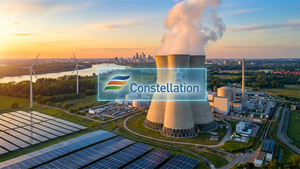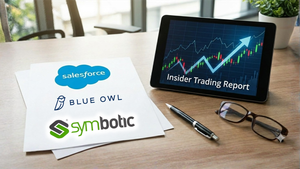
New York, NY – October 13, 2025 – Century Aluminum Company (NASDAQ: CENX) has captured significant attention in the financial markets, with its stock recently hitting a formidable 52-week high. This impressive surge reflects a confluence of strong tailwinds in the global aluminum market and strategic, forward-looking initiatives undertaken by the company. The upward trajectory of CENX not only signals investor confidence in the primary aluminum producer but also underscores a broader narrative of resilience and potential growth within the U.S. domestic manufacturing sector.
The rally in Century Aluminum's shares is a direct consequence of both favorable market dynamics, including rising aluminum prices and constrained global supply, and the company's aggressive moves to enhance its production capacity and operational efficiency. This performance positions Century Aluminum as a key player to watch, as the industry navigates evolving trade policies and a renewed focus on domestic production capabilities.
Strategic Moves and Market Forces Propel Century Aluminum's Ascent
Century Aluminum's journey to its 52-week high is rooted in several pivotal developments and a supportive market environment. A major catalyst has been the company's commitment to reactivating idle capacity at its Mt. Holly aluminum smelter. Through an extended power purchase agreement with Santee Cooper, secured through 2031, Century Aluminum is investing $50 million to bring an additional 50,000 metric tons of aluminum output online. This ambitious plan aims to restore the Mt. Holly plant to full production by early summer 2026, a level not seen since 2015, significantly boosting overall U.S. aluminum output by an estimated 10%.
Further bolstering the company's prospects is robust governmental support for the domestic aluminum industry. The Trump administration's decision to increase Section 232 tariffs on foreign primary aluminum imports from 25% to 50% without exclusions has been a significant boon. Century Aluminum has been a vocal proponent of these tariffs, asserting their importance for national security and job creation. This policy framework, coupled with the company's June 2025 announcement to construct the first new aluminum smelter in the U.S. in five decades—a move projected to double domestic production—highlights a strategic alignment with national economic interests. Financially, while the second quarter of 2025 presented a mixed bag with an earnings per share (EPS) miss, revenue surpassed expectations, demonstrating a robust 15.38% growth over the last twelve months. This strong financial performance, combined with analyst upgrades and a consensus "Strong Buy" rating, has fueled investor optimism.
The broader aluminum market has also played a crucial role in Century Aluminum's success. Aluminum prices have been on an upward trend throughout 2024, experiencing an annual growth of 7.75%, with projections for 2025 indicating a continuation of this trend, reaching levels of $2,700 per ton according to analysts like Goldman Sachs. This rise is attributed to a combination of high demand and persistent supply shortages. Global supply constraints, limited capacity growth—especially with China's production caps and high operating costs elsewhere—and trade barriers have created a tight market. Although alumina supply is expected to recover in 2025, potentially easing production costs, overall aluminum prices are not anticipated to decline sharply. The U.S. market, in particular, remains resilient, supported by steady industrial activity and consistent imports, though tightened domestic supply due to efforts to avoid tariffs makes internal disruptions more impactful. Century Aluminum's focus on sustainability, evidenced by improvements in environmental metrics and increased reliance on renewable energy from its Iceland operations, further adds to its appeal in an increasingly ESG-conscious investment landscape.
Ripple Effects: Winners and Losers in a Resurgent Aluminum Market
Century Aluminum's robust performance and the prevailing bullish trends in the aluminum market are creating a distinct bifurcation among other public companies in the sector, distinguishing potential winners from those facing significant headwinds. The landscape is being shaped by factors such as vertical integration, commitment to low-carbon production, and exposure to regional trade policies and energy costs.
Companies poised to benefit significantly are those that mirror Century Aluminum's strategic advantages. Primary aluminum producers with strong vertical integration, such as Alcoa (NYSE: AA), which operates across both alumina and aluminum production, are well-positioned to capitalize on high aluminum prices, provided they can effectively manage their alumina supply. Producers with access to affordable, renewable energy sources also gain a crucial competitive edge, given the energy-intensive nature of aluminum smelting and the global push for sustainable materials. U.S.-based primary producers, in particular, stand to benefit from the elevated U.S. Midwest premiums, driven by tariffs, creating a more protected and profitable domestic market. Furthermore, companies focused on secondary (recycled) aluminum production will likely thrive due to cost-effectiveness and environmental incentives, offering a degree of insulation from the volatility of primary aluminum and alumina prices.
Conversely, companies heavily reliant on external raw material supplies, exposed to high energy costs, or lacking strategic diversification may struggle. Primary aluminum smelters without captive alumina production or favorable long-term supply contracts, for instance, faced significant profit squeezes in 2024 due to record-high alumina prices. While some easing is expected later in 2025, continued volatility could impact profitability. UC Rusal, the Russian aluminum giant, is a notable example of a potential loser, having announced plans to cut up to 500,000 tonnes of output due to soaring alumina costs and supply constraints, exacerbated by international sanctions. European smelters, nearly 50% of which were offline by the end of 2023 due to persistently high power prices, will continue to face challenges if energy costs remain elevated. High-carbon primary aluminum producers may also incur significantly higher costs to export to key markets due to regulations like Europe's Carbon Border Adjustment Mechanism (CBAM), potentially losing competitiveness.
Downstream aluminum product manufacturers, including companies like Kaiser Aluminum (NASDAQ: KALU), Constellium (NYSE: CSTM), Arconic (NYSE: ARNC), Novelis, Ardagh Metal Packaging (NYSE: AMBP), and Mueller Industries (NYSE: MLI), face increased input costs due to the high prices of primary aluminum and elevated U.S. Midwest premiums. Unless they can fully pass on these increased costs to consumers, their profit margins are likely to compress. There is also a risk of demand destruction for high-value end products if sustained high aluminum prices encourage manufacturers to seek cheaper alternative materials. Companies unable to efficiently manage raw material procurement or innovate to reduce their reliance on high-cost primary aluminum could see a reduction in market share and profitability.
A Glimpse into the Future: Wider Significance and Broader Industry Trends
Century Aluminum's impressive run to a 52-week high is not merely an isolated corporate success story; it is a significant indicator of broader, transformative trends sweeping through the global aluminum market. The company's strategic decisions and financial trajectory illuminate critical drivers and challenges within an industry undergoing substantial evolution, influenced by shifting demand patterns, volatile energy costs, and an increasingly intricate regulatory environment.
The global aluminum market is projected for robust growth, with forecasts indicating a market size reaching $403.29 billion by 2032, expanding at a compound annual growth rate (CAGR) of 6.2%. This expansion is primarily fueled by surging demand from key sectors. The automotive industry, for instance, is increasingly adopting aluminum for lightweighting vehicles, crucial for improving fuel efficiency in conventional cars and extending the range of electric vehicles (EVs), which utilize significantly more aluminum. The construction, packaging, and electrical sectors also continue to be substantial demand drivers. Furthermore, aluminum is a critical material for the burgeoning renewable energy infrastructure, including solar panels and wind turbines, and plays a vital role in batteries and electrical grids, underscoring its importance in the global push towards electrification and decarbonization.
However, this bullish demand outlook is juxtaposed with persistent supply constraints and significant regulatory implications. The market anticipates a continued supply shortfall in 2025, a consequence of long lead times for new smelter projects, logistical hurdles, and constrained supplies of raw materials like bauxite and alumina. China's steadfast cap on aluminum production at 45.5 million tonnes further limits global output, contributing to a bullish price outlook that has seen aluminum futures reaching a three-year high of over $2,750 per tonne in October 2025. Energy prices remain a continuous pressure point, with electricity accounting for nearly 40% of total production costs in smelting. This vulnerability underscores Century Aluminum's proactive move to secure long-term power agreements, a strategy that could become a blueprint for others in the industry.
Regulatory and policy frameworks are profoundly shaping the market. Trade policies, such as import tariffs, create uncertainty and influence regional pricing and global trade flows. The U.S. market, for example, faces potential reimposition or increase of tariffs on Canadian aluminum, while past U.S. tariffs have consistently driven higher domestic prices. A major development is the European Union's Carbon Border Adjustment Mechanism (CBAM), which, after a transitional phase ending December 2025, will impose financial obligations on carbon emissions from imports starting January 2026. This initiative aims to incentivize low-carbon production globally but also introduces new layers of compliance and cost for producers. Environmentally, stricter regulations, including carbon emission standards and recycling mandates, are increasing operational costs, pushing producers to invest in cleaner technologies and efficient processes, such as increased scrap recovery.
Historically, the aluminum market has experienced long-term trends, often spanning decades. The surge in U.S. primary aluminum production during both World Wars highlighted its strategic importance. However, U.S. production steadily declined from its 1980 peak, reaching less than 1% of global primary production by 2024, a testament to shifts in competitive landscapes and energy costs. More recently, the European energy crisis in 2022, fueled by geopolitical tensions, caused up to 50% of Europe's primary aluminum capacity to be lost in 2021-2022 due to soaring energy prices. This serves as a stark reminder of the industry's susceptibility to energy market volatility and underscores the critical need for stable, affordable power—a challenge Century Aluminum is actively addressing with its long-term power agreements and investments in domestic production. The recognition of aluminum as a critical material by various U.S. government agencies also signals ongoing policy support for domestic investment to ensure national security and foster innovation.
The Road Ahead: Navigating Opportunities and Challenges
The trajectory of Century Aluminum (NASDAQ: CENX) and the broader aluminum market in the coming years will be defined by a delicate balance of capitalizing on emergent opportunities and mitigating persistent challenges. Both short-term maneuvers and long-term strategic pivots will be crucial in a landscape shaped by global sustainability mandates, geopolitical shifts, and the ever-present volatility of energy and raw material costs.
In the short term (next 12-24 months), Century Aluminum is poised for continued strong performance, largely driven by its strategic operational restarts and favorable U.S. market conditions. The planned restart of over 50,000 metric tons of idled capacity at its Mt. Holly facility, targeting full utilization by early summer 2026, is a key driver, bolstered by an extended power purchase agreement through 2031 and a $50 million investment. This expansion is expected to significantly boost output and economic contribution, while recent refinancing of senior secured notes extending to 2032 strengthens its financial footing. Analysts generally maintain a positive outlook, anticipating strong near-term performance. For the broader market, a moderate global aluminum deficit is expected in 2025, potentially growing in 2026, supported by rising demand and ongoing supply constraints, with aluminum prices expected to remain elevated, though forecasts vary.
Looking further ahead (beyond 24 months), Century Aluminum's long-term strategy focuses on solidifying its position through vertical and horizontal integration. This includes the acquisition of Jamalco, a bauxite mining and alumina refining operation in Jamaica, and ambitious plans for a new U.S. smelter capable of producing military-grade primary aluminum and other value-added products. This emphasis on high domestic U.S. production levels aligns strategically with growing U.S. protectionism and the push for secure supply chains. Potential strategic pivots for Century Aluminum could include further expansion of its U.S. footprint to capitalize on "onshoring" trends, deeper vertical integration to control raw material costs, and a greater shift towards specialized, higher-margin products to insulate from commodity price fluctuations. The broader aluminum market is projected for significant long-term growth, primarily fueled by the burgeoning electric vehicle (EV) sector, where aluminum's lightweight properties are critical for range and performance, and the massive build-out of renewable energy infrastructure. The aluminum recycling market is also booming, offering substantial growth as industries pivot towards a circular economy and demand for "green aluminum" intensifies.
However, significant challenges loom. For Century Aluminum, these include the persistent volatility of raw material (bauxite, alumina) and energy costs, despite its long-term power agreements. Broader macroeconomic headwinds and the potential for policy reversals, such as a change in U.S. trade tariffs, could also diminish its competitive advantage. For the wider market, geopolitical risks and trade wars continue to disrupt supply chains and create price volatility. High and volatile energy costs remain a critical threat, capable of forcing production curtailments, particularly in regions like Europe. Stringent environmental regulations and decarbonization pressures demand continuous investment in cleaner technologies, while potential oversupply in the coming years (as new smelters come online) could put downward pressure on prices.
Several scenarios could unfold. A "Bullish Demand & Protected Domestic Markets" scenario would see Century Aluminum thriving with high profitability and successful expansion, while the global market remains robust with premiums for "green aluminum." Conversely, a "Global Economic Slowdown & Tariff Reversal" could lead to reduced demand, increased competition, and delayed expansion plans for Century, with significant price declines for the broader market. A "Sustainability-Driven Transformation" would accelerate the shift towards low-carbon aluminum and recycling, benefiting companies with strong ESG credentials and efficient recycling infrastructure. Lastly, a "Geopolitical Volatility & Supply Chain Disruption" scenario would test the resilience of all players, with Century Aluminum's diversified operations potentially offering some insulation but still facing global price volatility and increased focus on localized, resilient supply chains. Century's long-term success will hinge on its ability to manage these complex dynamics, adapt to sustainability demands, and navigate global market uncertainties.
Conclusion: Navigating a Dynamic Aluminum Future
Century Aluminum's (NASDAQ: CENX) recent achievement of a 52-week high is a testament to its strategic foresight and the prevailing bullish sentiment in the global aluminum market. This significant milestone, marked by an 85.41% increase over the past year and a staggering 426% gain over three years, underscores robust investor confidence and the company's strong financial health, as evidenced by its 15.4% revenue growth and "GREAT" rating from InvestingPro. The landmark power deal for its Mt. Holly facility, extended until 2031, is a pivotal development, enabling a $50 million investment to reactivate idle smelting capacity, projected to boost production by 50,000 metric tons and create over 100 new jobs.
Moving forward, the aluminum market appears poised for continued strength, with a projected shift from a slight surplus in 2024 to a supply deficit in 2025, potentially increasing further in 2026. This deficit is driven by sluggish production growth, a gradual recovery in consumption, and constraints in Chinese production, coupled with rising demand from the energy transition and electromobility sectors. U.S. aluminum premiums are expected to remain high, supported by reshoring initiatives and government tariffs, positioning Century Aluminum favorably to meet growing domestic demand. However, potential risks include uncertainties in China's economic recovery, drought impacts, and new production capacity in 2026 that could exert downward price pressure.
The lasting impact of Century Aluminum's current trajectory lies in its reinforcement of strategic advancements within the company and its contribution to the broader narrative of a resilient domestic aluminum industry. The Mt. Holly power agreement ensures operational stability and boosts capacity, particularly for value-added products, while the company's commitment to sustainability, evidenced by reduced greenhouse gas emissions and increased reliance on renewable energy from its Iceland operations, enhances its market appeal. While some analysts view the stock as modestly overvalued, a discounted cash flow (DCF) model by Simply Wall St suggests potential for considerable upside, despite the company's inherent sensitivity to aluminum price fluctuations, energy costs, and competitive pressures.
Investors should closely monitor several key areas in the coming months. Fluctuations in global aluminum prices will directly influence Century Aluminum's financial performance, making the upcoming earnings report on November 3, 2025, a critical event. Progress on the Mt. Holly expansion, the evolving global supply and demand dynamics, and any shifts in trade policies or geopolitical stability will also be crucial. Given the company's vulnerability to energy price fluctuations, competitive power arrangements and stable energy sources are vital for profitability. Finally, while analyst sentiment generally leans towards a "Buy," the stock's "high risk" classification and significant daily price movements necessitate vigilance and careful consideration of differing price targets and sustainability efforts.
This content is intended for informational purposes only and is not financial advice






